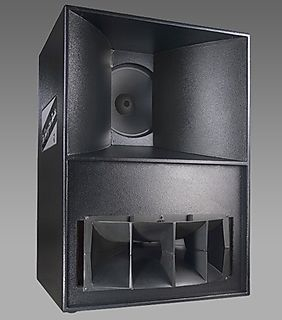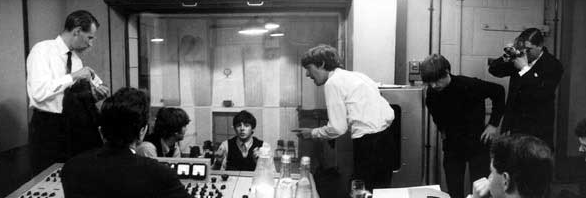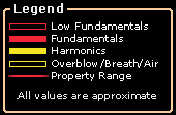hselburn wrote:I have been looking into Monitors. I've heard, though I've not auditioned yet, the Presonus Eris 8. I did attempt to listen to some monitors at last years AES but try really hearing anything in an expo setting. Yeah. right. LOL. The thing is The. Eris 8 goes down to 35hz without a sub. At $500 for the pair, if they are as good as I've read, they could be a good deal. The only headphones I would consider monitoring through are so expensive as to take them out of contention. They are made by Audeze. I know one legendary engineer who uses them when he's on the road, but not in his own studio. They cost $2000 for their top model. As for other monitors, I heard the m-audio box-8'and they gave me a headache. They may be good for techno or hip hop but as that's not what I'm doing, and the fact that I don't want my monitors to give me a headache, no thanks. LOL. I really appreciate your post and I'm going to go through it a few times to make sure I didn't miss anything.

Thanks!
Howell
As noted in one of my first posts to the topic where Notion Music announced the new association with PreSonus, I did a bit of research on the PreSonus studio monitors and was surprised in a pleasant way with the overall specifications, since I think that with the deep bass response is sufficient that the ARC System 2 (IK Multimedia) can pull it into a reasonable full-range zone, but even though this appears likely, the fundamental problem exists, which is the "big and heavy" aspect, and the rules of acoustic physics cannot be violated . . .
To put this into perspective, the Surfwhamy sound isolation studio is approximately 6 feet wide by 7 feet high and 12 feet long, which makes it about the size of a walk-in closet, and the studio monitor system I use consists of a pair of Kustom KPC15P 15" Two-Way Powered PA Speakers and a pair of Kustom PA112S Powered Sub Woofers, as shown in the following photographs . . .
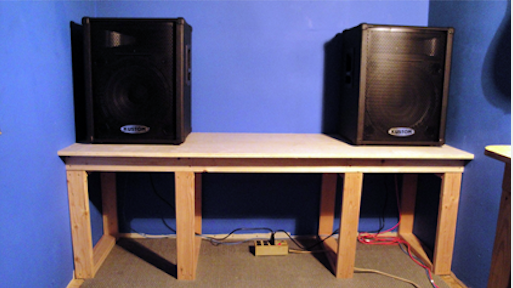
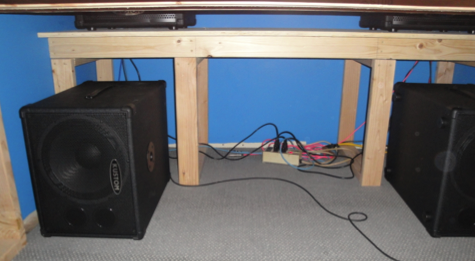
These units are vastly overpowered for the size of the sound isolation studio, but I run them at a very low volume (approximately 2.5 on a scale of 0 to 10), and I check everything with a NADY DSM-1 Digital SPL Meter to ensure that the maximum volume is no greater than 90 to 94 dB SPL, which is very important because in this small a room these units are so powerful that they can do permanent hearing damage, and for reference I recommend wearing OSHA-approved hearing protection during the time when one is configuring the units and the overall system, because even with a room 20 feet wide by 20 feet long and 12 feet high, these units are vastly overpowered . . .
Nevertheless, there is an advantages to running them at such low volume levels, and one of the advantages is that the power amplifiers have plenty of headroom and dynamic range, which maps to being able to handle rapid transients without distorting and is one of the characteristics that audiophiles value, for good reasons . . .
Explained in a simple way, if you are running a 10-watt amplifier at maximum, then it has no headroom, but if you run a 100-watt amplifier at a low volume that matches the power of a 10-watt amplifier running at maximum, then the the 100-watt amplifier has plenty of headroom, reserve power capability, or whatever to handle rapid increases without distorting, and the same thing happens with the loudspeakers (woofers, horns, tweeters, and so forth) . . .
Based on current prices in the US at Musician's Friend, each pair of the Kustom self-powered loudspeaker units is approximately $400 (US), but Musician's Friend usually has a discount promotion with a coupon code, and most of the time these discount promotions apply to the Kustom self-powered loudspeaker units, where in some instances the additional discount maps to 15 percent, and the strategy is to do two separate purchases so that each purchase qualifies for the discount, which with a bit of thoughtful shopping and perhaps having more than one Musician's Friend account maps to reducing the cost by as much as 15 percent, which is more than enough to cover the required cables and Tripp-Lite surge protector power strips, where for reference I recommend and use GLS Audio cables . . .
You can start with a pair of Kustom KPC15P 15" Two-Way Powered PA Speakers; NADY DSM-1 Digital SPL Meter; Tripp-Lite ISOBAR8ULTRA surge protector; and set of GLS Audio cables to connect everything, and this is a very nice studio monitor system for a while, but it needs to be enhanced with a pair of Kustom PA112S Powered Sub Woofers, which you can do as your budget allows, and the Kustom PA112S Powered Sub Woofers are
not optional for the complete system, because with the addition of the Kustom PA112S Powered Sub Woofers, the studio monitor system goes subsonic, which is what makes it literally amazing . . .
Later you will want to add a Behringer DEQ2496 Ultra-Curve Pro, which among other things is the external signal processor you will use to do Real-Time Analysis (RTA) and calibration using the separately ordered Behringer calibrated microphone, which is important because this makes it possible to calibrate the studio monitor system separately from the ARC System 2 calibration, where the strategy is to use the Behringer unit to get the studio monitor system as closely calibrated as possible but then to use the ARC 2 System (a) to do final more detailed and precise computer-based calibration and (b) to get a chart showing the response of the system before and after the ARC System 2 calibration, where the chart is what you use to do a bit of "by ear" fine-tuning using the Behringer unit with an emphasis on making only tiny adjustments (+/- 3 dB at most), primarily in the subsonic and deep bass ranges once you have the pair of Kustom PA112S Powered Sub Woofers, which you can do because while they are not specifically rated to go subsonic, you are running them at such low volume levels that you can push them just enough in a small room to go subsonic . . .
Another reason for the ARC System 2 is that they chart it produces will provide clues to the acoustic characteristics of your studio, and once you understand how everything works with respect to the acoustic behaviors of studios, listening rooms, and home theaters you can identify any "hot spots" or other types of problem areas and then do various room treatments, where for example the Surfwhammy sound isolation studio has a "hot spot" around 70-Hz that makes the deep bass "boomy", so once I realized this I corrected the problem with 6 rolls of fiberglass insulation and 5 cubes of compressed cellulose, which is an easy and relatively inexpensive way to solve the problem and by doing so transforms the way everything sounds from (a) "boomy" and indistinct to (b) crisp, clear, distinct, punchy, and tight . . .
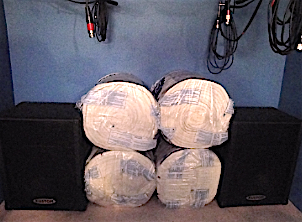
One of the more curiously fascinating aspects of having a calibrated full-range studio monitor system is discovering that motion pictures have subsonic and deep bass even though with most playback systems you never hear it because the ability to reproduce subsonic and deep bass is not there, and if your studio has a fully floated floor, as does the Surfwhammy sound isolation studio, then you actually feel the subsonic bass . . .
The audio information is present in the motion picture soundtracks, because the studios where the audio work is done all have calibrated full-range studio monitor systems and the music composers, foley, and audio folks specifically include subsonic and deep bass, but other than in a motion picture theater you never hear it, because so-called "home systems" cannot reproduce the subsonic and deep bass . . .
One of the things I like to do when someone visits is to play their favorite song or to let them watch a favorite motion picture in the sound isolation studio, and it is fascinating to watch their expressions and responses, because most people have not heard music and motion picture soundtracks as they actually were recorded and heard in professional studios, where a good analogy is taking someone to a symphony performance where you have very good seats when they have only heard a symphonic orchestra on the television, and it nearly always maps to their having an epiphany . . .
THOUGHTSYou can do a reasonably good "by ear" adjustment without having the Behringer unit and the ARC System 2, but you need the NADY DSM-1 SPL Meter, and I recommend doing the initial procedure while wearing OSHA-approved ear protectors like airport workers wear when working around commercial jet aircraft . . .
~ ~ ~ Continued in the next post ~ ~ ~ 



